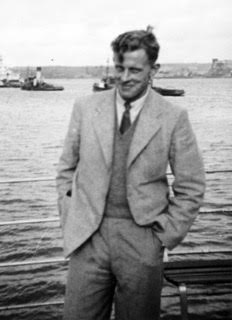Painting from history: two artists at work
Cllr Tom Wright, Mayor of Budleigh Salterton,
admires Millais' 'The Boyhood of Raleigh' on the opening day of
Fairlynch Museum's Raleigh 400 exhibition, 28 May 2018
John Washington’s sketch of Roger
Conant the peacemaker has been well received both locally in Devon and in the
USA. We’re looking forward to seeing how his depiction of a dramatic event 400
years ago in far-off Massachusetts will develop from what is just the artist’s
working drawing.
With Roger Conant’s Devon boyhood
Budleigh Salterton beach, looking east to Otter
Head
One hundred and fifty years ago
the PreRaphaelite artist Sir John Everett Millais decided that our pebble beach
– known by some as the place where the late Princess Diana took secret walks
with her lover – would be the perfect setting for his depiction of a moment in
the life of a very different character from Devon’s history.
Portrait of Sir Walter
Raleigh in All Saints' Church, East Budleigh. This is a copy of one of the best known portraits of
Sir Walter formerly attributed to Zuccaro but now to the monogrammist 'H' (?
Hubbard) and dated 1588. It shows Raleigh in court dress at the height of his
favour with Queen Elizabeth I. Raleigh had been appointed Captain of the Guard
in 1587.
What greater contrast could there
be between the flamboyant, arrogant but brilliant Elizabethan courtier Sir Walter Raleigh and the ‘tolerant, mild and conciliatory, quiet and unobtrusive, ingenuous and
unambitious’ founder of Salem as he’s been
described by one 19th century historian.
Above: Hayes Barton, Raleigh's birthplace a few
miles outside East Budleigh, with an illustration of the village's Mill House, where Roger Conant grew up. Sadly, the building was demolished
Yet both were born in the same
century in the same tiny Devon village of East Budleigh. And both are
associated with the history of two of the USA’s best known regions.
The Octagon, on Budleigh's Fore Street
So Millais came to Budleigh
Salterton in the late 1860s, settled in a studio on our fair town’s Fore Street
within a few yards of the famous beach, supposedly engaged a brawny and tanned
local ferryman as a model and set to work painting an imagined scene from the
life of a great English hero. The result, in which he also used his own son as
a model, was the very successful ‘The Boyhood of Raleigh’. The painting, first
exhibited in 1870, is now one of the masterpieces in the collection of Tate
Britain.
'The Boyhood of Raleigh', watched by 'Sir Walter',
being carefully unloaded at Fairlynch Museum after its journey from Tate
Britain
In 2018 to mark the 400th
anniversary of Raleigh’s death, Budleigh’s Fairlynch Museum staged one of its
most successful exhibitions. One of the highlights was Millais’ painting, on
loan from London to Budleigh for only the third time in its 150-year life.
In the
steps of a master: John Washington in costume as
Sir John
Everett Millais
Part of the Museum’s celebrations
was a re-enactment of Millais’ work close to where the Victorian artist would
have worked. Who better to play the part of Millais himself and paint the scene
than our John Washington.
Local children were volunteered
to act as models. Our ‘brawny sailor’ was nobly played by the Museum’s former
treasurer Nick Speare who managed to keep his arm outstretched for hours on
end, with a few breaks of course.
Riding Donut from Budleigh Salterton Riding
School is Rob Batson, in costume as Raleigh, meeting his double
To amuse the crowds of
spectators, curious to see the latest performance by Budleigh eccentrics, we
even had two adult Raleighs on the scene, one on horseback.
Group photo of the actors in our 'Boyhood'
re-enactment
It was a scorcher of a day and my
false beard kept falling off, much to my discomfiture as I played the part of
one of England’s heroes. But it was good fun and we have some fabulous photos
of the event thanks to the very talented and professional Rob Coombe from
Dorset-based Matt Austin Images.
The Extent of the British Empire in 1886, made
by J. C. R. Colomb, Supplement to the Graphic magazine 24 July
1886, with British territories coloured red Artist: Walter Crane
(1845-1915)
So it won’t be the first time
that an artist working from a Budleigh studio has tackled the subject of a
celebrated moment in history. Millais’ painting, of course, was full of
historical inaccuracies and really just amounted to a pleasing piece of
Victorian propaganda about what were seen as the glorious beginnings of the British Empire.
Continued at
https://budleighpastandpresent.blogspot.com/2020/06/history-in-art-arms-and-men.html
You can access other posts on this blog by going to the Blog Archive (under the ‘About Me’ section) on the left of the screen, and clicking on the appropriate heading.
Continued at
https://budleighpastandpresent.blogspot.com/2020/06/history-in-art-arms-and-men.html
You can access other posts on this blog by going to the Blog Archive (under the ‘About Me’ section) on the left of the screen, and clicking on the appropriate heading.













Comments
Post a Comment